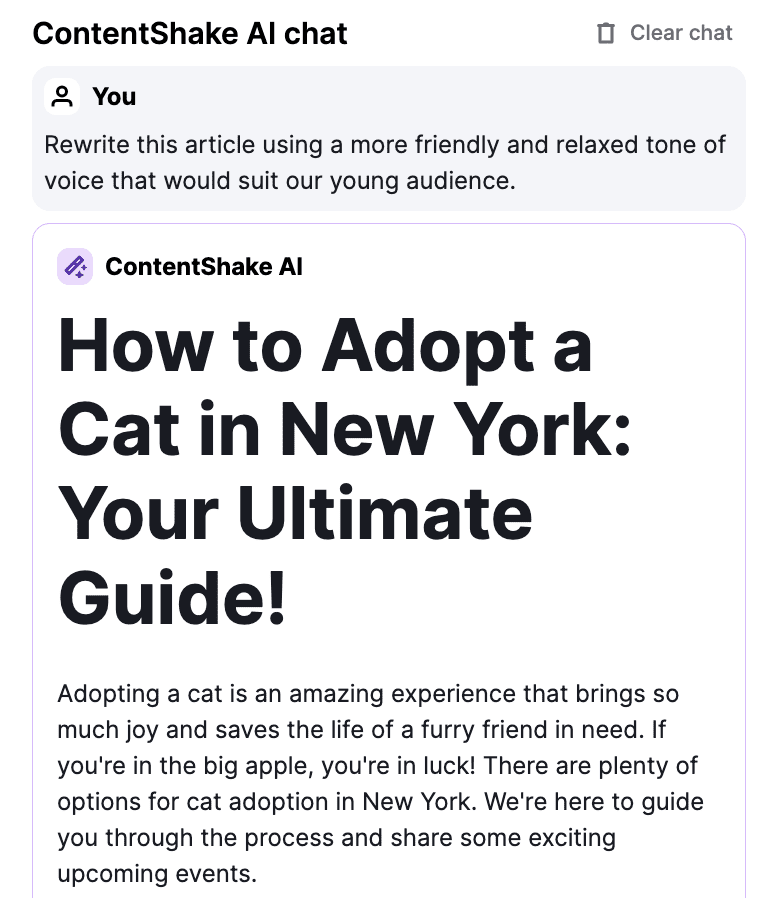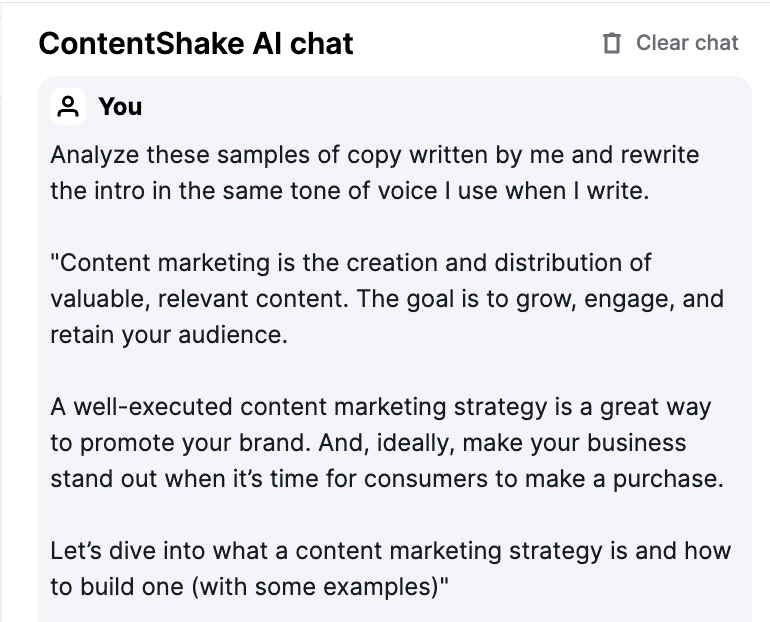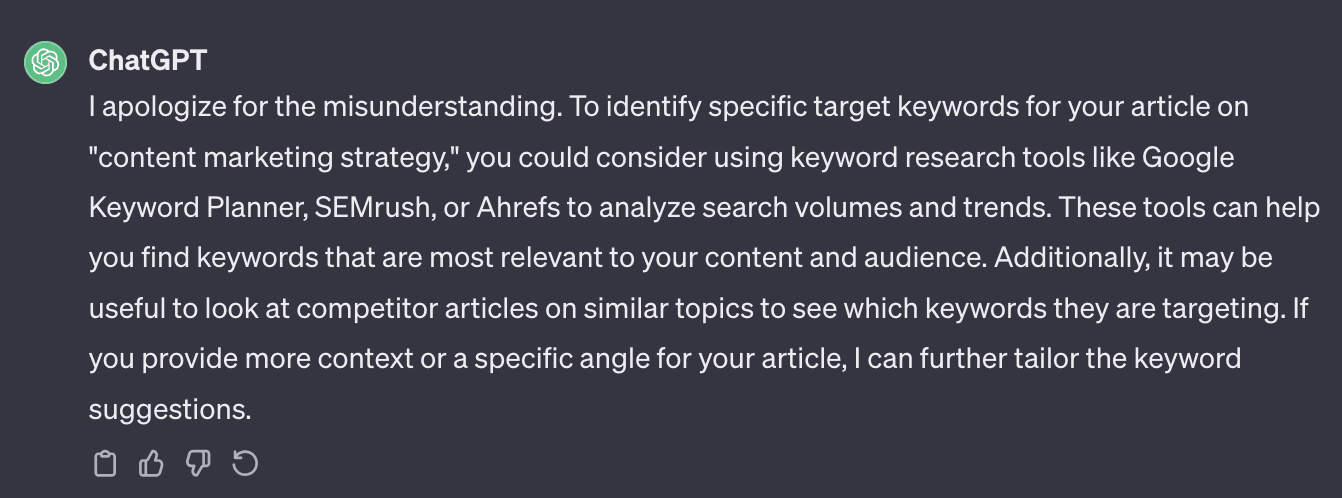
Using AI marketing can help you save numerous resources and get better results, faster.
But it can be hard to know where to get started.
Let’s take a look at exactly what AI marketing is, how it can help your content marketing strategy, and why it’s so cost-efficient.
We’ll cover some key tips for using AI to generate marketing content so you can really make the most out of it.
What Is AI Marketing?
AI marketing is a digital marketing strategy that uses AI tools and algorithms to create, optimize, and distribute content.
The objective of this content is most often to attract, engage, and convert your target audiences.
You can use AI to automate and enhance content-related tasks. Ultimately, it will allow you to create more targeted, efficient, and data-driven content strategies.
The AI content you create should be valuable to your audience, but also optimized for search engines and user preferences.
The outcome will be to drive better results for your marketing department.
Try these new AI-powered tools
- Jasper.ai is an AI content tool that ensures your brand’s tone is maintained in your content creation.
- Copymatic can automatically generate content both text and image for your website or blog.
- SimpleTraffic drives real visitors to your content. Try 5 days for free and cancel anytime.
- Artsmart.ai is one of the easiest AI image generators to use. Create anything you can imagine.
How can AI benefit your content marketing strategy?
But why use AI?
The main benefit of using AI to create and optimize your content is that it can save you both time and money.
AI will always be faster than a human writer. And if used correctly, you’ll be able to create content that reads naturally and scores highly for SEO.
If you outsource the writing to AI, you can allocate your resources more efficiently.
As a result, your team can spend more time on high-value tasks and achieve better ROI on your content marketing spend.
But what if you usually write the content yourself?
In this case, AI can help you dramatically increase the content output, polish the overall writing, and help you focus on managing your business.
Together with AI, you can:
- Instantly create content of any kind
- Research and brainstorm ideas
- Analyze large amounts of data
- Find ideas and opportunities for promoting and distributing your content
- Polish and enhance your content strategy
- Enhance your SEO and generate more organic traffic
- Optimize and improve your existing content and draft
- Better understand your target audience
- Save time and money on all of the above
Now, let’s see how to do it right.
8 practical tips for using AI in marketing
So, you’re ready to get AI to do some of the heavy lifting when it comes to content marketing tasks.
It’s time to push your marketing to the next level, slim your marketing spend, or boost your billing rates!
But even the best tool needs some human input.
So, how can you wield AI content tools for the most effective results?
We’ve compiled a few tips for you to keep in mind when you’re starting out.
1. Combine AI with human supervision
Despite AI’s epic potential, you will need people in the loop.
You can’t leave all your strategy, content planning, and production to a machine—as tempting as it may be!
For example, there’s no denying that AI marketing can work well, but it works even better when you pair it with a subject matter expert and an editor.
Combining real-life expertise and original research with AI’s creation capabilities is the best way to make your content stand out.
Here are some examples of how you can achieve this:
- Provide AI with extra information from your own experience (e.g., a case study with a client) when generating and editing your content
- Use AI to help you frame questions, summarize, and edit interviews with experts
- Research using AI to generate questions you may not have thought to ask an expert
- Use AI to summarize articles, PDFs, and other content to discover new talking points or trends
- Edit the final drafts and fact-check the information generated by AI
- Add useful images (e.g., screenshots) to your content
- Give AI guidelines on the tone of voice you tend to use in your content
- Run your content by the subject matter expert(s) before publishing it
2. Know your audience and tell AI about it
You need to know what your target audience wants to engage with before you start.
Otherwise, your AI tools are writing blind.
Make sure you know your audience’s preferences, pain points, and interests so you can better tailor AI-generated content to your audience’s needs.
That way, each piece of content will help you build strong connections with readers and drive engagement.
For example, imagine you’re writing an article about adopting a cat in New York.
Using the AI chat in the ContentShake AI writing tool, we asked to create a paragraph on using social media for cat adoption as our audience is young and active online.
HOW TO DEFINE YOUR AUDIENCE FOR AI TOOLS
- Demographics: Give your AI tool any relevant demographic information as this may better guide your AI content output and tone. You’ll usually include some of the following information: Age, gender identity, location, education level, income, job position, etc.
- Attitude and behavior: Describe how your customer relates to your brand. Are they seeking advice? Or perhaps they have a more transactional relationship? Also consider the challenges they have, their goals, and their current solutions. This information can help guide both the tone and output of your AI tool.
3. Define your tone of voice and make sure AI understands it
AI text generators can help you write with a consistent tone of voice.
Most AI content writing tools allow you to choose a tone of voice, ranging from academic to friendly and informal.
You can even create the same article in different styles to see what fits best with your brand’s tone of voice, and what is going to resonate with your audience.
However, it’s best to stick to a consistent tone of voice throughout your content.
Tools like ContentShake AI will even automatically score your copy’s tone of voice and highlight bits of text that need to be fixed.
You can also specify your preferred tone of voice when generating content with AI.
For example, you can provide it with instructions:
You can also feed AI examples of your work to help it understand your own unique tone of voice.
Let’s explore some tips and tricks for defining and maintaining a tone of voice in AI-generated content.
DOS AND DON’TS WHEN DEFINING YOUR TONE OF VOICE FOR AI
| Do | Don’t |
| • Be specific. For example, is the tone professional, friendly, humorous, empathetic, etc.? Make sure you use descriptive adjectives to get this across to your AI tool.
• Provide context: Share the brand, audience, and purpose of the content with the AI tool. • Use examples: If you can, give examples of text that demonstrate your brand’s tone of voice to serve as a reference. • Set boundaries: Remember to include what is NOT acceptable in your brand’s tone (e.g., negative language, jargon). |
• Be vague: Avoid vague or generic instructions. This can lead to content that doesn’t match your expectations.
• Be confusing or contradictory: Details ARE important, but super-complex prompts can confuse the AI. • Forget to proofread: Nobody’s perfect—not even AI. Make sure you proofread and edit. • Rely solely on it: A human editor is essential; over and above proofreading, a real person will be able to see the subtle mistakes or out-of-brand language that a machine would miss. • Ignore culture: You need to be aware of cultural and contextual nuances, especially when creating content for diverse audiences. Try to prompt your AI with the background, but this is also a matter for your human editor. |
4. Use AI marketing tools with real-time SEO data
There are multiple ways that AI can be useful for SEO.
For example, you can use it to analyze if your copy includes your target keywords, implement keyword clustering, find backlinking and interlinking opportunities, and more.
However, right now many AI tools don’t provide real-life data on such essential SEO elements as keywords and search intent.
To address this, you can combine AI with manual research and specialized SEO tools.
Another option is to use specialized writing tools that offer both AI content generation and SEO data.
ContentShake AI is one example of a writing tool that does this.
It suggests content ideas and creates ready-to-publish, SEO-rich content in one click.
The tool combines ChatGPT’s AI functionality with Semrush’s SEO data and a content-friendly interface.
5. Don’t worry about SEO repercussions
One of the common concerns related to using AI marketing is the possibility of getting penalized by Google.
But, is this a real risk?
Not really.
Search engines, like Google, do not penalize content produced by AI as long as it’s valuable and relevant.
Google states: “Appropriate use of AI or automation is not against our guidelines.”
What matters is that your content presents value to the readers and answers their questions.
So, does it matter if your content is written by AI?
No.
Does it matter if it’s high-quality, has a good structure, covers the topic fully, and presents original ideas?
Absolutely. This also holds true for human-written content.
Google states:
“AI has the ability to power new levels of expression and creativity, and to serve as a critical tool to help people create great content for the web.”
So, go ahead and create with AI.
Just be sure that what you create has value for your readership.
6. Get creative and opt for multimedia content
You don’t have to limit content produced by artificial intelligence to just text.
You can use AI tools to create multimedia content: generating images, creating and editing videos, and producing AI voices.
This can help make content more relatable and shareable.
The multimedia content you create can also serve multiple platforms—from owned media like your blog and newsletters to social media, video platforms, etc.
Diversifying the content types and media in your strategy is also important to hedge against potential risks.
The growing content output means that the competition will only increase, especially when it comes to SEO.
So, don’t keep all your eggs in one basket.
7. Embrace the learning curve
Like any new process, it will take time for you to get comfortable with the AI tools you’re using.
Don’t expect to churn out perfect content from day 1.
You’ll need to go through a process of trial and error as you work on your prompt engineering, figure out each step of multistep prompts, and tinker with your process.
Here are some tips you could use to get better results with AI marketing:
- Be specific. When writing prompts, provide information about your audience, the tone of voice, and the specific content you want to generate.
- Don’t expect to always get a perfect result from the first attempt. Just like when dealing with people, sometimes we need to provide additional details and ask questions when working with AI.
- Integrate AI in your daily life. The more you try using AI, the more familiar you’ll get with it and the faster you’ll be achieving the expected result.
Remember, practice makes perfect!
8. Measure performance
Much like work produced by humans, you need to measure the performance of articles produced by AI.
You should establish KPIs prior to planning and creating content.
Then, it’s key to track them and notice patterns.
For example, if your goal is to increase awareness and generate more traffic, it’s key that you analyze rankings and organic traffic.
Other KPIs can include conversions, shares, leads, ROI, and more.
Your ability to establish goals and measure them is key to creating a content strategy that generates real-life business results.
Besides, AI tools like ChatGPT and other AI chatbots can also help find solutions for low-performing content.
For instance, with the paid version, you can upload a list of keywords and your page’s copy and ask AI to suggest options for improving the keyword density.
Wrapping Up
Using AI helps us produce marketing content faster before delivering it to our target audiences.
It also means that anyone—even people without content expertise—can now enhance their content with ease and grow their business organically.
As business owners, writers, and marketers embrace these technologies, we’ll see more valuable content than ever from brands and companies.
The right AI tools—combined with a smart strategy—will make sure that you don’t get left behind.






















